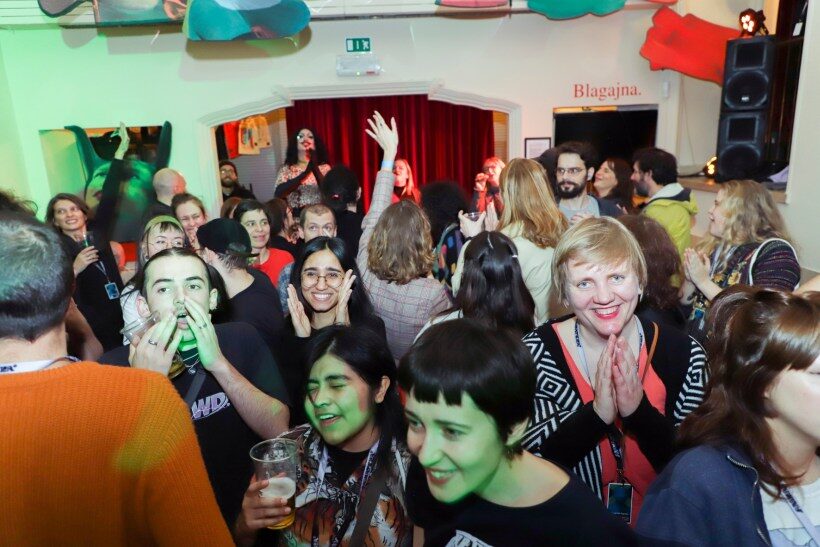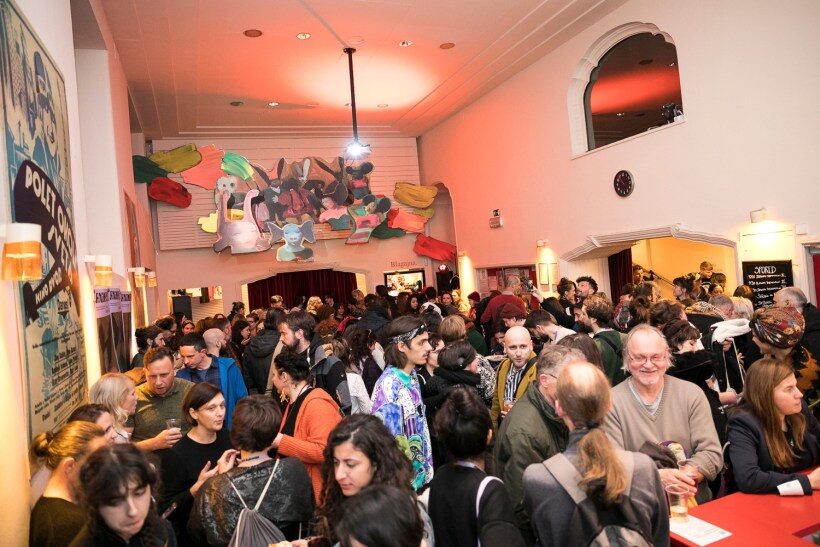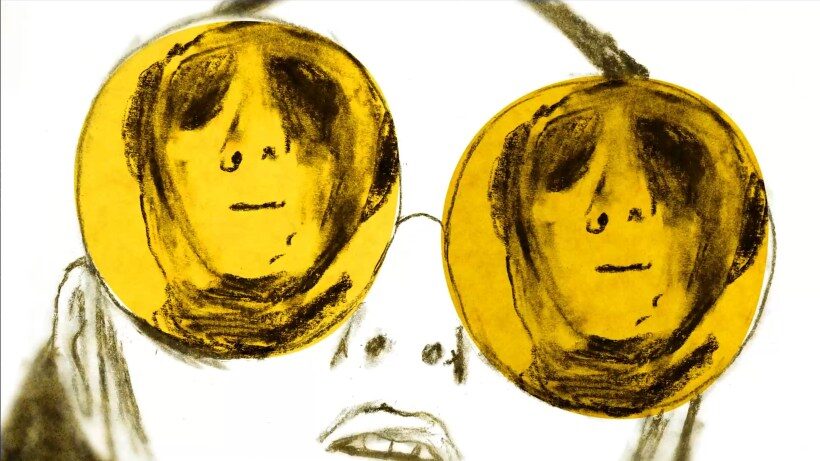A filmmakers Q&A – not right after the film but on the following day, and on top of that in a different venue, isn’t that a terrible idea? Won’t the auditorium be empty? The answer is a definite no: Because many people come to the Q&As that festival director Igor Prassel organises every single day of the 20th anniversary edition of Animateka (27.11.-3.12.) together with Chris Robinson – whose main job is the direction of the Ottawa International Animation Festival, yet he also serves as an advisor to the Slovenian animation institution. Sometimes as many as 60 people show up. What appears to be a minor miracle is in fact the purest and most natural Animateka DNA: After all, the “respect for the author,” which Prassel repeatedly emphasises, is particularly tangible at the Q&As. For example, in his own well-thought-out questions, which never seem to strain the audience’s attention despite their nerdiness. And also in the lines, he and Chris Robinson throw at each other, even if there’s some bro humour involved, from time to time. So basically, the audience turns up to appreciate the appreciation of the two of them, no matter how short the previous rakija night was (usually very short).

Opening © Andrej Firm
The fact that appreciation is a top priority at Animateka becomes apparent at many other points during the festival. Take, for example, the introductions before the competitions, where not a single filmmaker is ever forgotten (some of whom sometimes come forward to throw old festival t-shirts into the delighted crowd as gifts – a festival tradition to be celebrated). But the appreciation is also reflected in the programme itself, which always seeks a connection to the history of animation, emphasising values such as loyalty and solidarity. Gianluigi Toccafondo created this year’s wonderful festival trailer (and not a younger “cool kid”) – after having already realised the trailer for Animateka’s first festival year. As for Chris Robinson, his screening series “Collage Animation” honoured a tradition from its beginnings (including Terry Gilliam) to the grand masters such as Martha Colburn to current representatives of this technique such as Stacey Steers with her fabulous THE NIGHT HUNTER. The fact that around 300 festival guests came to Ljubljana this year has a lot to do with the festival’s genuflexion to the medium of animation – even filmmakers who don’t necessarily feature a film in the programme attend this special kind of festival encounter.

Karaoke © Marijo Zupanov
Encounter, the hackneyed magic word for all festivals, really does take on a very special significance at Animateka. You could also say that it is completely unavoidable in Ljubljana. After all, the festival with all its scheduled events takes place in just two screening rooms in the city’s own Kinodvor cinema and in the film-historical Kinemateka, while all the important parties – the annual karaoke night (that reportedly came to be as an animation film festival tradition at Animafest Zagreb), which this year was hosted by two drag queens, as well as the opening and closing parties with their delicious buffets – are squeezed into the Kinodvor foyer, so that you find yourself dancing with everyone and no festival encounter, no matter how insignificant, remains hidden from view. It is this sense of intimacy, for which many people keep returning time and time again, that Prassel believes must be preserved – even though it can sometimes get very crowded and cinema tickets are scarce. He himself suspects that from 2025 on (when Animateka will be able to take over two additional screens in the Kinodvor arthouse multiplex that is currently being built), he will have to realign the programme, especially as he would like to turn the festival more into a festival for the audience without becoming too commercial. A balancing act.

Kinodvor © Andrej Firm
And never forget your roots! In keeping with the beautiful, medieval setting of the south-eastern European capital, Prassel cultivated his critical eye for and on the (animation) history already during his training as a journalist. He then became editor of the comic Stripburger. He got around a lot and acquired networking skills before he was infected with the animation virus 23 years ago at the Pesaro Film Festival: The 100-Years-Of-Animation programme that was presented there is an ongoing source of inspiration to this day. Under the name Animateka, Prassel began organising retrospectives on the history of animation at the Slovenian Cinematheque, which he dedicated to the old masters, among them Daniel Szczechura, Norman McLaren, Émile Cohl, and Jan Švankmajer, true to his motto “We should never forget the pioneers.” The actual festival then developed from these retrospectives.
Prassel also quickly identified one of Animateka’s USPs in terms of content: The competition was not intended to represent the state of the art regarding worldwide animation, as was the case in Annecy, but to consciously show what was being produced in the home country as well as in neighbouring regions, i.e. Central, Southern and Eastern Europe. How did Switzerland find its way into this cluster? The production conditions were not always as good as they are today, explains Prassel, perhaps somewhat meekly. Thus, the Animateka competition not only offers a view into the region, but is also a veritable springboard for young talents, even within their own countries. For example, this is where Špela Čadež’s career kicked off, whose STEAKHOUSE was shortlisted for the Academy Awards last year.
In addition to a panorama programme, the rest of the rather Western animation world can be enjoyed in the “Best of the World” programme, but there’s also a feature-length programme, special events as well as AnimatekaPRO with master classes and other formats, the Elephant programme for the little ones and the student competition, uniting all countries of origin. For the first time this year, a VR competition was also organised in which 10 different works competed against each other. The winner of this competition was a VR experience about a breeze blowing through the city and landscape and its transformation into a storm, the very poetic and beautifully crafted FLOW VR by Adriaan Lokman, Lucid Realities/Valk Productions. The delicate 3D animations appear as if they have been thrown onto the page or into the VR environment.

It’s just a whole © Bianca Scali, Animationsinstitut, Filmakademie-Baden-Württemberg
The two other main prizes also went to two works that are strongly influenced by their analogue haptic qualities: Bianca Scali won the student competition with her IT’S JUST A WHOLE; a film that draws a great deal from the paper textures that she combines with digital animation. Meanwhile, Marta Magnuska secured the Grand Prix with her MISALIGNED for her lack of fear in the face of a blank page, or, as the jury puts it” This film uses the space of the flat white screen freely.“ Magnuska uses charcoal drawings to capture the progressive alienation within a relationship in a claustrophobic way and with a great sense of timing and space. Only the audience contrasted the Animateka juries’ penchant for the handmade – which seems to fit particularly well with Animateka and its reference to tradition – with a completely contemporary view: It presented the Audience Award to HARDLY WORKING by Total Refusal, which once again “defamiliarises” a computer game, more specifically: NPCs (non-playable characters) in Red Dead Redemption 2, on the basis of whose (in)activities the collective Total Refusal acts out its Marx-infused critique of capitalism. Very entertaining, but also very didactic.

Misaligned © Marta Magnuska
Speaking of craftsmanship and heritage: Igor Prassel, now 52, is also aware that a festival can only ensure its survival if it not only upholds the achievements of the past, but also invests in future generations. This not only applies to the programme but also to the organisation. For several years now, he has involved Ana Šturm as curator for the student competition, and he has also largely delegated the children’s programme. In addition, Chris Robinson offers advice on the finalisation of the competition programme. However, when Prassel stands on stage and moderates all the important events himself with the right mix of information, humour, and nonchalance, only to have a beer with everyone afterwards, you wonder how Animateka will flourish in the post-founder’s age. But why look so far ahead. Until then, we can all still enjoy a few more years of homegrown, classical animation film festival leadership in the very best sense of the word.